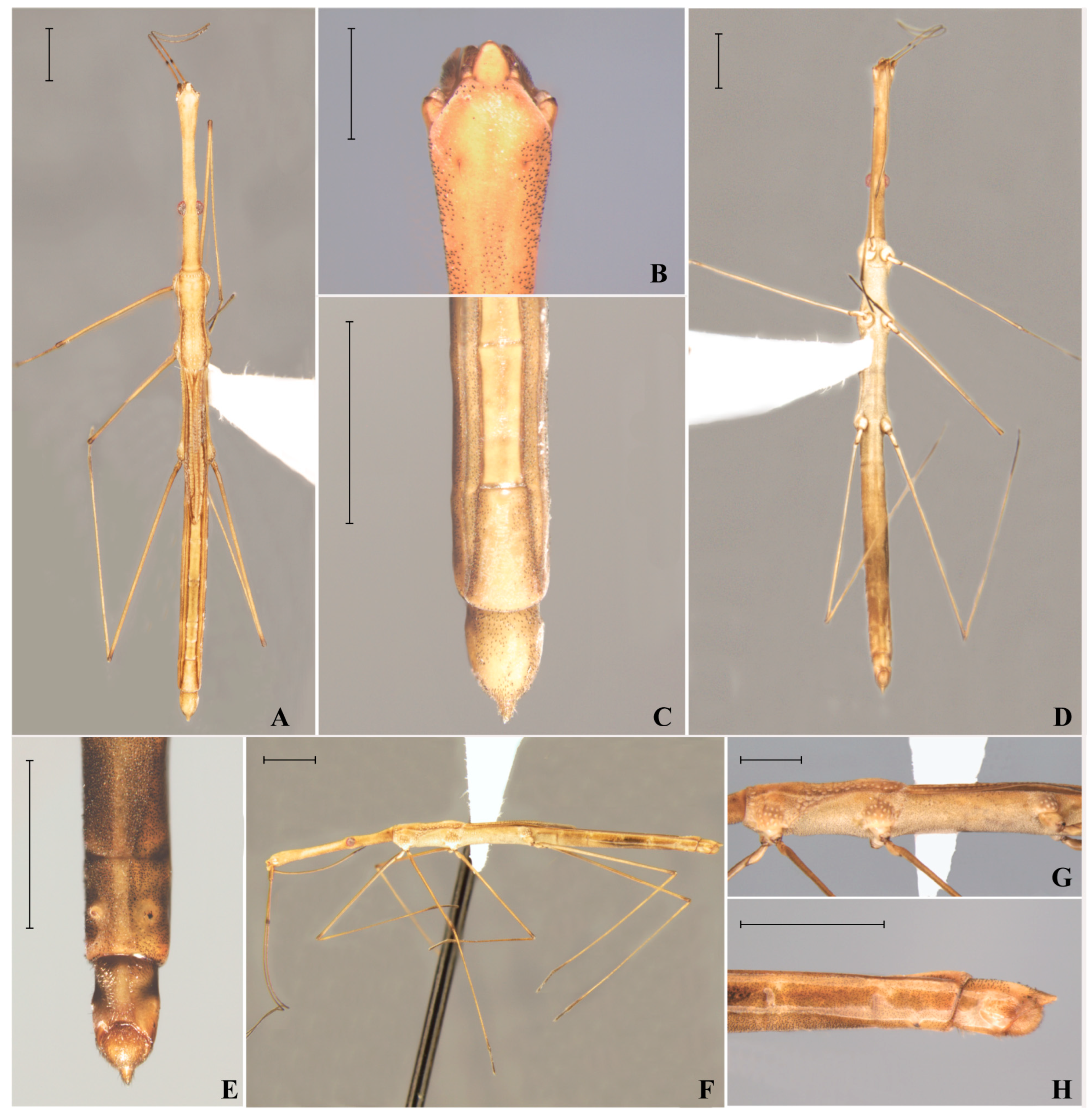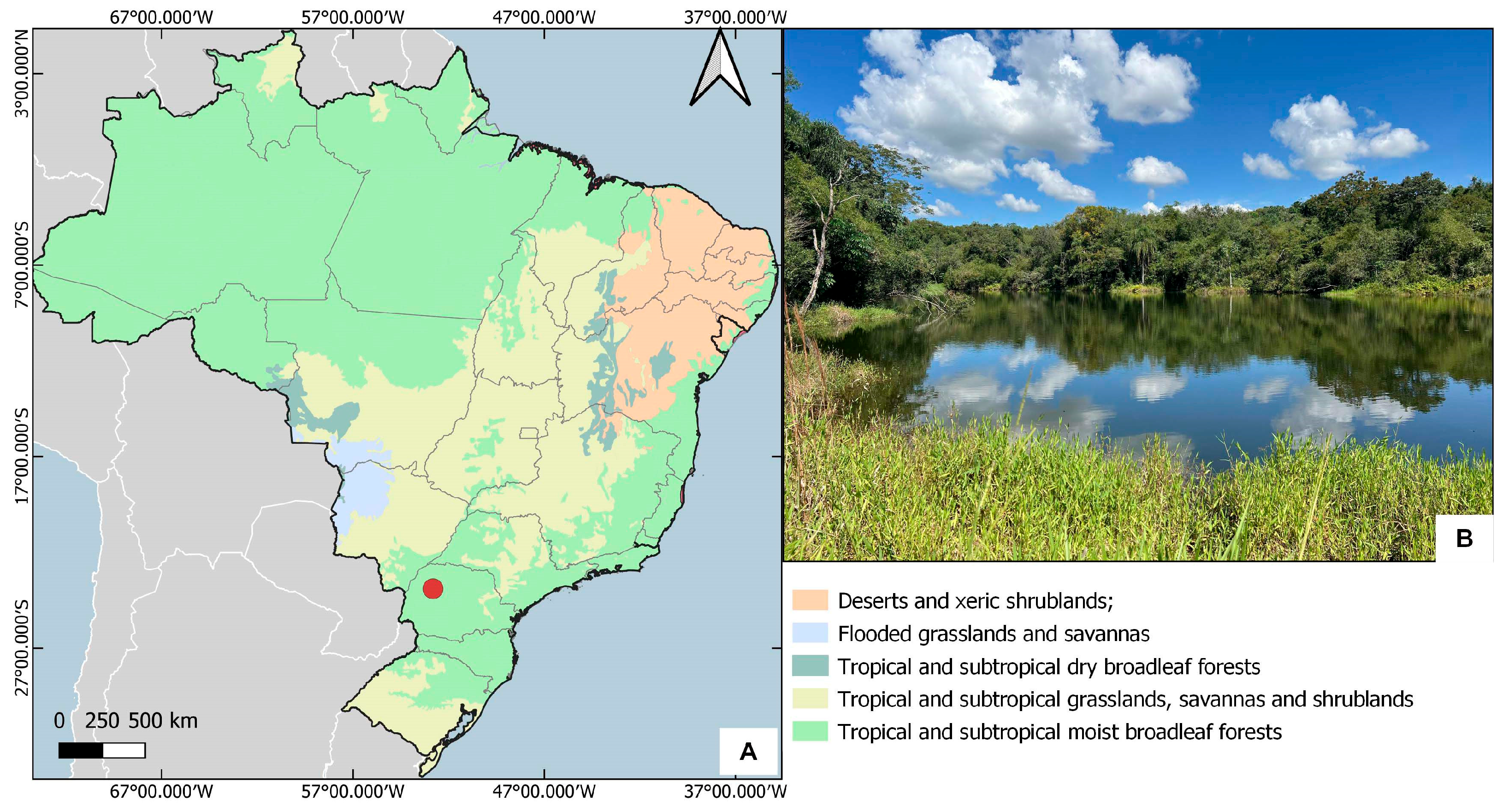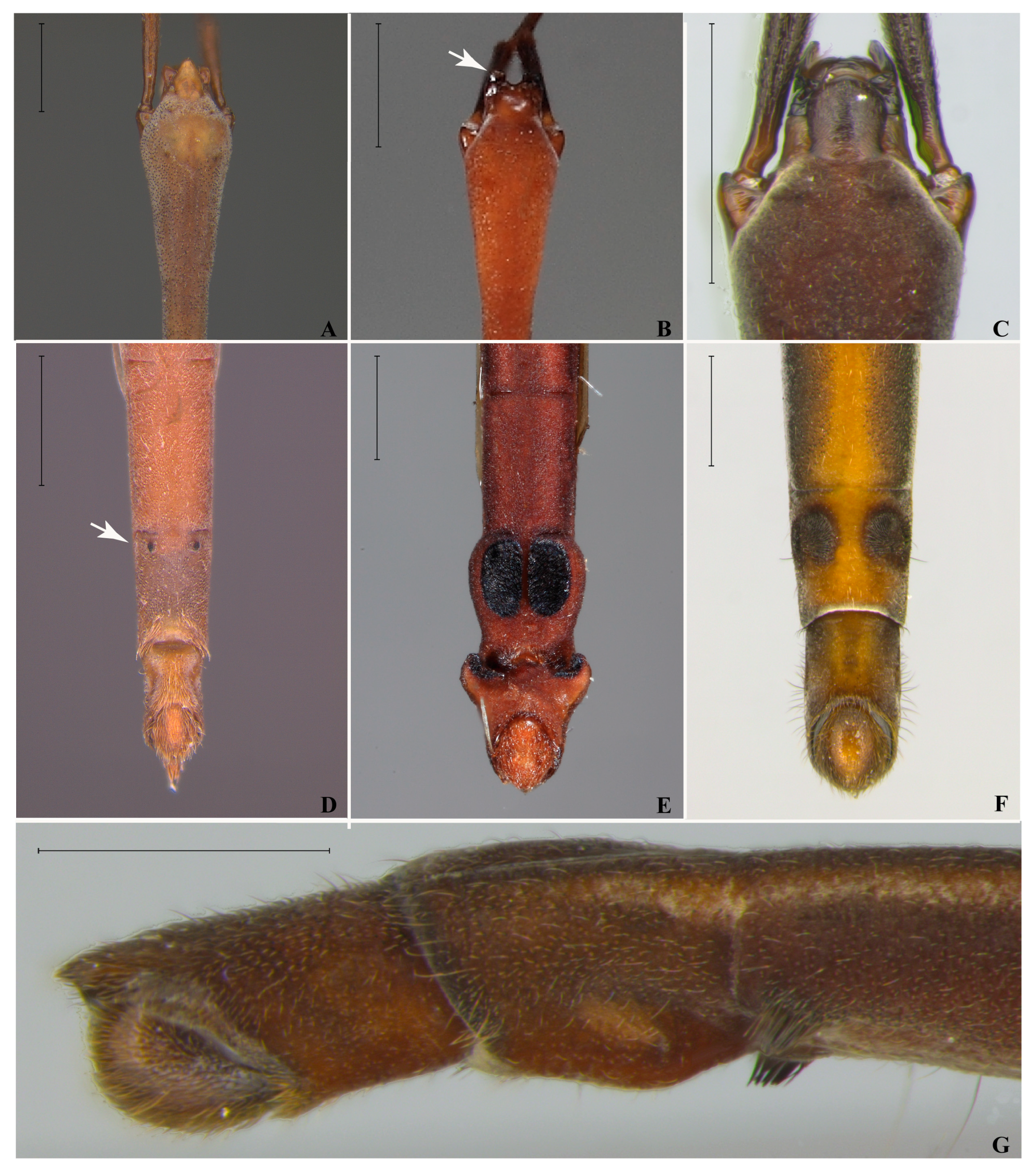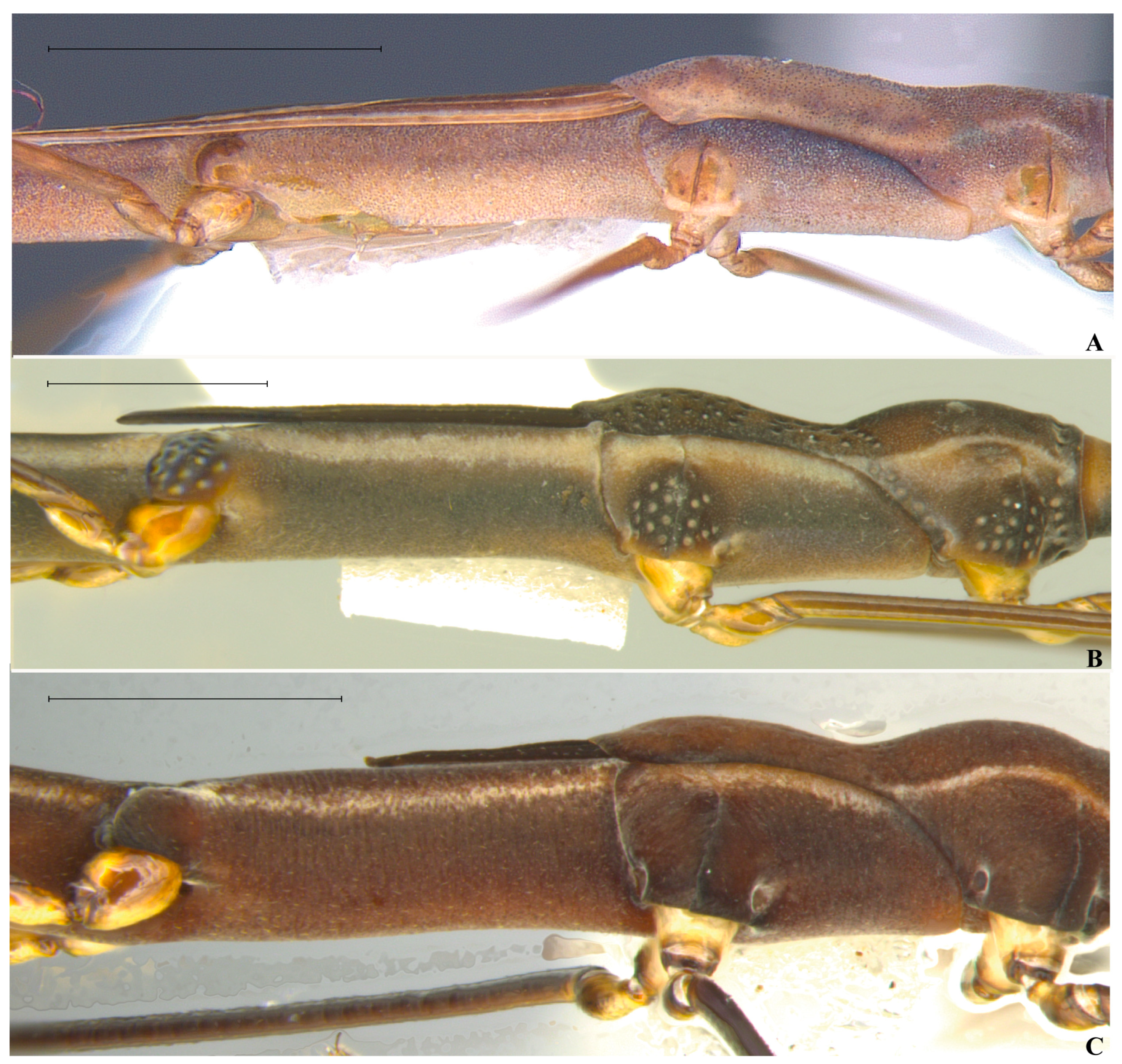Description of a New Species and Revised Key to the Hydrometra Latreille, 1797 (Hemiptera: Gerromorpha: Hydrometridae) Recorded from Brazil †
Simple Summary
Abstract
1. Introduction
2. Materials and Methods
3. Results
3.1. Description
3.2. Key to the Hydrometra Recorded from Brazil
- 1.
- Anterior margin of clypeus excavated (Figure 3B) …… H. comata Torre-Bueno, 1926
- -.
- Anterior margin of clypeus acute, truncated or rounded, never excavated (as in Figure 3A,C) ……………………………………………………………………… 2
- 2.
- Male abdominal sterna VI and VII without projections or tufts of setae …………………………………………………..… H. sapiranga Moreira & Barbosa, 2013
- -.
- 3.
- -.
- 4.
- Male abdominal segment VIII with large lateral hooks (Figure 3E) ……………………………………………………………... H. sztolcmani Jaczewski, 1928
- -.
- Male abdominal segment VIII without large hooks (as in Figure 3D,F) …… 5
- 5.
- Pro- and mesoacetabula with 0–2 circular punctures or punctations (as in Figure 5A,C) ………………………………………………………………..…………….… 6
- -.
- 6.
- Male abdominal sternum VII with a large oval area bearing setae, where length of area is larger than half of sternum length (Figure 4C) ……………...… H. metator White, 1879
- -.
- Male abdominal sternum VII with a pair of short, spinose projections anteriorly (Figure 3D) ……………………………………………………..… H. argentina Berg, 1879
- 7.
- -.
- 8.
- Anterior half of male abdominal sternum VII with a pair of small elevations bearing dark setae (Figure 4D); posterior half with a central depression ………………………………………………………………….. H. olallai Mychajliw, 1961
- -.
- 9.
- Male abdominal sternum VII with a pair of mammilose projections joined by a wide transverse ridge (Figure 4A) ………… H. fruhstorferi Hungerford & Evans, 1934
- -.
- Male abdominal sternum VII with a pair of small elevations bearing dark setae (Figure 1E,H) ……………… H. perobas Cordeiro, Floriano & Moreira, sp. nov.
- 10.
- Male abdominal sternum VII with a pair of large circular areas bordered by black setae (Figure 3F) ………………… H. tuberculata Cordeiro, Rodrigues & Moreira, 2023
- -.
- Male abdominal sternum VII with a pair of clusters of setae with the shape similar to a semi-circle or a comma (Figure 4B,E) ……………………….………….… 11
- 11.
- Male abdominal sternum VII with a pair of clusters of setae on posterior half, with each cluster forming an almost closed circle (Figure 4B) …………………………………………………. H. guianana Hungerford & Evans, 1934
- -.
- Male abdominal sternum VII with the pair of clusters of setae extending posteriorly, each cluster similar to a comma (Figure 4E) … H. caraiba Guérin-Méneville, 1857
4. Discussion
5. Conclusions
Author Contributions
Funding
Institutional Review Board Statement
Informed Consent Statement
Data Availability Statement
Conflicts of Interest
References
- Andersen, N.M. The Semiaquatic Bugs (Hemiptera, Gerromorpha) Phylogeny, Adaptations, Biogeography and Classification; Scandinavian Science Press: Klampenborg, Denmark, 1982; 455p. [Google Scholar]
- Polhemus, J.T.; Polhemus, D.A. Global diversity of true bugs (Heteroptera; Insecta) in freshwater. Hydrobiologia 2008, 595, 379–391. [Google Scholar] [CrossRef]
- Armisén, D.; Viala, S.; Cordeiro, I.R.S.; Crumière, A.J.J.; Hendaoui, E.; Le Bouquin, A.; Duchemin, W.; Santos, E.; Toubiana, W.; Vargas-Lowman, A.; et al. Transcriptome-based phylogeny of the semi-aquatic bugs (Hemiptera: Heteroptera: Gerromorpha) reveals patterns of lineage expansion in a series of new adaptive zones. Mol. Biol. Evol. 2022, 39, msac229. [Google Scholar] [CrossRef] [PubMed]
- Moreira, F.F.F. The semiaquatic gerromorphans. In True Bugs (Heteroptera) of the Neotropics; Panizzi, A.R., Grazia, J., Eds.; Springer Science + Business Media: Dordrecht, The Netherlands, 2015; pp. 113–156. [Google Scholar]
- Polhemus, D.A.; Ferreira, R.L. Two unusual new genera of cavernicolous Hydrometridae (Insecta: Heteroptera) from eastern Brazil. Tijdschr. Entomol. 2018, 161, 25–38. [Google Scholar] [CrossRef]
- Martínez, D.C.; Galindo-Malagón, X.A.; Molano, F.; Moreira, F.F.F. Descriptions, records, and key to the Hydrometra Latreille, 1796 (Hemiptera: Heteroptera: Hydrometridae) from Colombia. Zootaxa 2019, 4577, 51–72. [Google Scholar] [CrossRef] [PubMed]
- Rodrigues, J.M.S.; Cordeiro, I.R.S.; Floriano, C.F.B.; Paiva, N.O.; Magalhães, O.M.; Joaquim Júnior, E.A.; Martins, T.S.; da Silva, R.C.; Siqueira, G.V.; Salles, F.F.; et al. Descriptions of new species and new records of water bugs (Hemiptera: Heteroptera: Gerromorpha & Nepomorpha) from southeastern Brazil. Zootaxa 2023, 5393, 1–86. [Google Scholar] [CrossRef] [PubMed]
- Perez-Goodwyn, P.J. A new Hydrometra species from Argentina (Heteroptera: Hydrometridae). Fla. Entomol. 2001, 84, 127–130. [Google Scholar] [CrossRef]
- Drake, C.J. Synonymical data and description of a new Hydrometra (Hemiptera: Hydrometridae). J. Kans. Entomol. Soc. 1953, 26, 40–41. [Google Scholar]
- Hungerford, H.B.; Evans, N.E. The Hydrometridae of the Hungarian National Museum and other studies in the family. (Hemiptera). Ann. Mus. Natl. Hung. 1934, 28, 31–112. [Google Scholar]
- Moreira, F.F.F.; Barbosa, J.F. A new Hydrometra (Hemiptera: Heteroptera: Hydrometridae) from northeastern Brazil, with a key to the species recorded from the country. Zootaxa 2013, 3619, 70–74. [Google Scholar] [CrossRef] [PubMed]
- Boeger, W.A.; Valim, M.P.; Zaher, H.; Rafael, J.A.; Forzza, R.C.; Percequillo, A.R.; Serejo, C.S.; Garraffoni, A.R.S.; Santos, A.J.; Slipinski, A.; et al. Catálogo Taxonômico da Fauna do Brasil: Setting the baseline knowledge on the animal diversity in Brazil. Zoologia 2024, 41, e24005. [Google Scholar] [CrossRef]
- Moreira, F.F.F. Hydrometridae in Catálogo Taxonômico da Fauna do Brasil. Available online: http://fauna.jbrj.gov.br/fauna/faunadobrasil/20008 (accessed on 26 March 2025).






Disclaimer/Publisher’s Note: The statements, opinions and data contained in all publications are solely those of the individual author(s) and contributor(s) and not of MDPI and/or the editor(s). MDPI and/or the editor(s) disclaim responsibility for any injury to people or property resulting from any ideas, methods, instructions or products referred to in the content. |
© 2025 by the authors. Licensee MDPI, Basel, Switzerland. This article is an open access article distributed under the terms and conditions of the Creative Commons Attribution (CC BY) license (https://creativecommons.org/licenses/by/4.0/).
Share and Cite
Floriano, C.F.B.; Cordeiro, I.d.R.S.; Rodrigues, J.M.d.S.; Paiva, N.d.O.; Passos, A.C.; Moreira, F.F.F. Description of a New Species and Revised Key to the Hydrometra Latreille, 1797 (Hemiptera: Gerromorpha: Hydrometridae) Recorded from Brazil. Animals 2025, 15, 2468. https://doi.org/10.3390/ani15172468
Floriano CFB, Cordeiro IdRS, Rodrigues JMdS, Paiva NdO, Passos AC, Moreira FFF. Description of a New Species and Revised Key to the Hydrometra Latreille, 1797 (Hemiptera: Gerromorpha: Hydrometridae) Recorded from Brazil. Animals. 2025; 15(17):2468. https://doi.org/10.3390/ani15172468
Chicago/Turabian StyleFloriano, Carla Fernanda Burguez, Isabelle da Rocha Silva Cordeiro, Juliana Mourão dos Santos Rodrigues, Nathália de Oliveira Paiva, Ana Carolina Passos, and Felipe Ferraz Figueiredo Moreira. 2025. "Description of a New Species and Revised Key to the Hydrometra Latreille, 1797 (Hemiptera: Gerromorpha: Hydrometridae) Recorded from Brazil" Animals 15, no. 17: 2468. https://doi.org/10.3390/ani15172468
APA StyleFloriano, C. F. B., Cordeiro, I. d. R. S., Rodrigues, J. M. d. S., Paiva, N. d. O., Passos, A. C., & Moreira, F. F. F. (2025). Description of a New Species and Revised Key to the Hydrometra Latreille, 1797 (Hemiptera: Gerromorpha: Hydrometridae) Recorded from Brazil. Animals, 15(17), 2468. https://doi.org/10.3390/ani15172468






